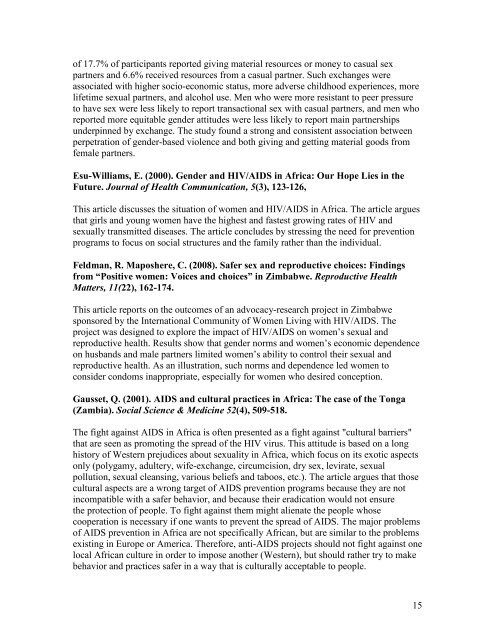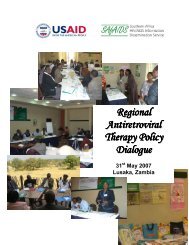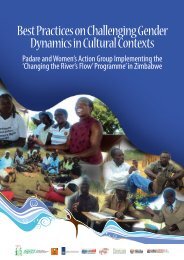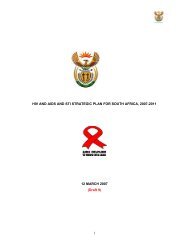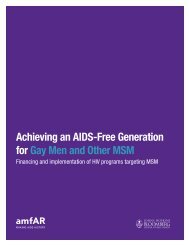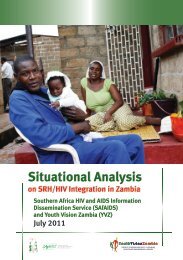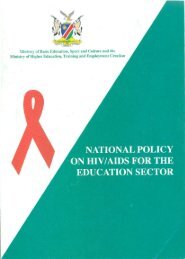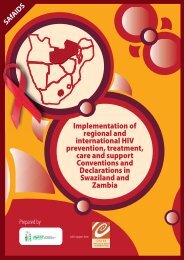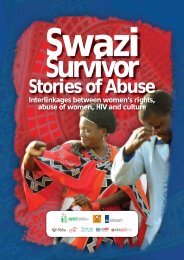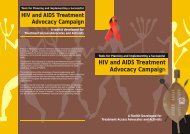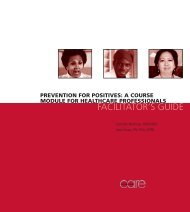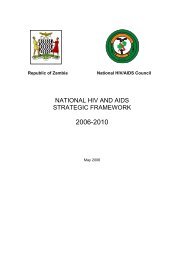esearchers identify several behavioral and social factors increasing the vulnerability ofmarried female adolescents to HIV infection. Among these factors are (a) frequentunprotected sex, (b) the likelihood of having much older husbands, (c) the likelihood ofbeing in polygamous marriages, and (d) having little bargaining power due to their ageand marriage hierarchy. The study emphasizes the need for tailored policies andinterventions responding directly to the unique vulnerabilities of this demographic.Duffy, L. (2005). Culture and context of HIV prevention in rural Zimbabwe: Theinfluence of gender inequality. Journal of Transcultural Nursing, 16(1), 23-31.This study explored factors facilitating or hindering rural Ndau women's participation inHIV prevention that might influence health promotion programming. Ethnographicmethods were used with a sample of 38 females and 10 males. Women's existence isrevealed as difficult and oppressive. Their socialization to become workers and mothersoccurs within a context of limited voice, subservience, violence, and economicpowerlessness, all barriers to HIV prevention. Through analysis of sociocultural andeconomic factors, it is suggested that cultural beliefs and practices, along with nationaland international forces, support and sustain gender inequality. For a change in the AIDScrisis, prevention strategies need to be multifaceted, consider people's culture andcontext, and include gender analysis.Dunkle, K. L., Jewkes, R. K., Brown, H. C., Gray, G. E., McIntyre, J. A., & Harlow,S. D. (2004). <strong>Gender</strong>-based violence, relationship power, and risk of HIV infection inwomen attending antenatal clinics in South Africa. Lancet, 363(9419), 1415-1421.This research included a cross-sectional study of 1366 women in Soweto, South Africa,who accepted routine antenatal HIV testing. In addition, private face-to-face interviewswere conducted and included assessment of sociodemographic characteristics, experienceof gender-based violence, the South African adaptation of the Sexual Relationship PowerScale (SRPS), and risk behaviours including multiple, concurrent, and casual malepartners, and transactional sex. Findings suggest links across intimate partner violence,high levels of male control in a woman's current relationship, and HIV seropositivity.Child sexual assault, forced first intercourse, and adult sexual assault by non-partnerswere not associated with HIV serostatus. These findings suggest that women with violentor controlling male partners are at increased risk of HIV infection. We postulate thatabusive men are more likely to have HIV and impose risky sexual practices on partners.Dunkle, K. L., Jewkes, R., Nduna, M., Jama, N., Levin, J., Sikweyiya, Y., et al.(2007). Transactional sex with casual and main partners among young SouthAfrican men in the rural Eastern Cape: Prevalence, predictors, and associationswith gender-based violence. Social Science & Medicine, 65(6), 1235-1248.This study examined the prevalence and predictors of transactional sex with casualpartners and main girlfriends among 1288 men aged 15–26 from 70 villages in the ruralEastern Cape province of South Africa. Data were collected through face-to-faceinterviews with young men enrolling in the Stepping Stones HIV prevention trial. A total14
of 17.7% of participants reported giving material resources or money to casual sexpartners and 6.6% received resources from a casual partner. Such exchanges wereassociated with higher socio-economic status, more adverse childhood experiences, morelifetime sexual partners, and alcohol use. Men who were more resistant to peer pressureto have sex were less likely to report transactional sex with casual partners, and men whoreported more equitable gender attitudes were less likely to report main partnershipsunderpinned by exchange. The study found a strong and consistent association betweenperpetration of gender-based violence and both giving and getting material goods fromfemale partners.Esu-Williams, E. (2000). <strong>Gender</strong> and HIV/AIDS in Africa: Our Hope Lies in theFuture. Journal of Health Communication, 5(3), 123-126,This article discusses the situation of women and HIV/AIDS in Africa. The article arguesthat girls and young women have the highest and fastest growing rates of HIV andsexually transmitted diseases. The article concludes by stressing the need for preventionprograms to focus on social structures and the family rather than the individual.Feldman, R. Maposhere, C. (2008). Safer sex and reproductive choices: Findingsfrom “Positive women: Voices and choices” in Zimbabwe. Reproductive HealthMatters, 11(22), 162-174.This article reports on the outcomes of an advocacy-research project in Zimbabwesponsored by the International Community of Women Living with HIV/AIDS. Theproject was designed to explore the impact of HIV/AIDS on women’s sexual andreproductive health. Results show that gender norms and women’s economic dependenceon husbands and male partners limited women’s ability to control their sexual andreproductive health. As an illustration, such norms and dependence led women toconsider condoms inappropriate, especially for women who desired conception.Gausset, Q. (2001). AIDS and cultural practices in Africa: The case of the Tonga(Zambia). Social Science & Medicine 52(4), 509-518.The fight against AIDS in Africa is often presented as a fight against "cultural barriers"that are seen as promoting the spread of the HIV virus. This attitude is based on a longhistory of Western prejudices about sexuality in Africa, which focus on its exotic aspectsonly (polygamy, adultery, wife-exchange, circumcision, dry sex, levirate, sexualpollution, sexual cleansing, various beliefs and taboos, etc.). The article argues that thosecultural aspects are a wrong target of AIDS prevention programs because they are notincompatible with a safer behavior, and because their eradication would not ensurethe protection of people. To fight against them might alienate the people whosecooperation is necessary if one wants to prevent the spread of AIDS. The major problemsof AIDS prevention in Africa are not specifically African, but are similar to the problemsexisting in Europe or America. Therefore, anti-AIDS projects should not fight against onelocal African culture in order to impose another (Western), but should rather try to makebehavior and practices safer in a way that is culturally acceptable to people.15
- Page 2 and 3: TABLE OF CONTENTSIntroduction …
- Page 4 and 5: PROCESSThe bibliography was created
- Page 6 and 7: ANNOTATED BIBLIOGRAPHYSUMMARY OF RE
- Page 8 and 9: Agha, S., & Van Rossem, R. (2002).
- Page 10 and 11: Bell, E. (2005). Advocacy training
- Page 12 and 13: were present, the participants freq
- Page 16 and 17: George, E. R. (2007). Virgin territ
- Page 18 and 19: Gwebu, T. D. (2007). The gendered r
- Page 20 and 21: Israel-Ballard, K. A., Maternowska,
- Page 22 and 23: This study examined gender attitude
- Page 24 and 25: experience of intimate partner viol
- Page 26 and 27: to young people, especially young w
- Page 28 and 29: ethical and cultural issues. In thi
- Page 30 and 31: that public health and behavioral s
- Page 32 and 33: conception among the group. This pr
- Page 34 and 35: Thomas, F. (2007). Global rights, l
- Page 36 and 37: sex outside marriage motivates most
- Page 38 and 39: As the annotated bibliography above
- Page 40 and 41: Focus Project /Program Country Orga
- Page 42 and 43: Focus Project /Program Country Orga


